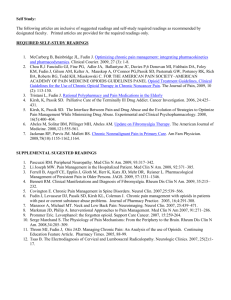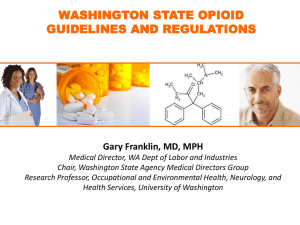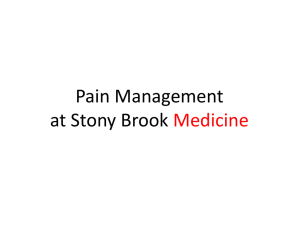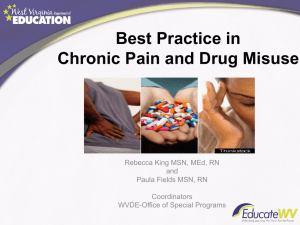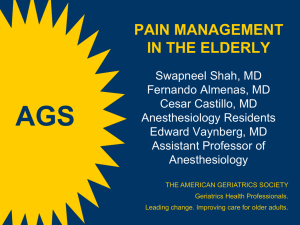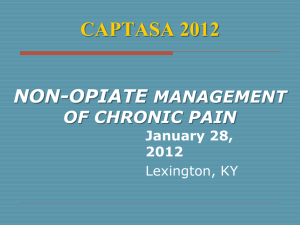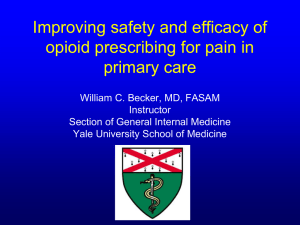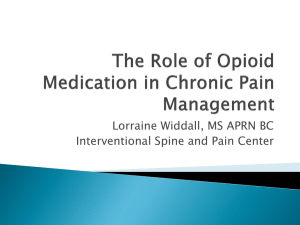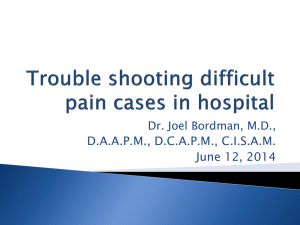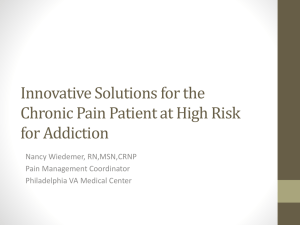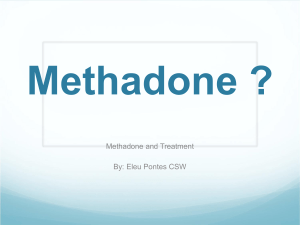Module 8: Pain Management Therapy
advertisement
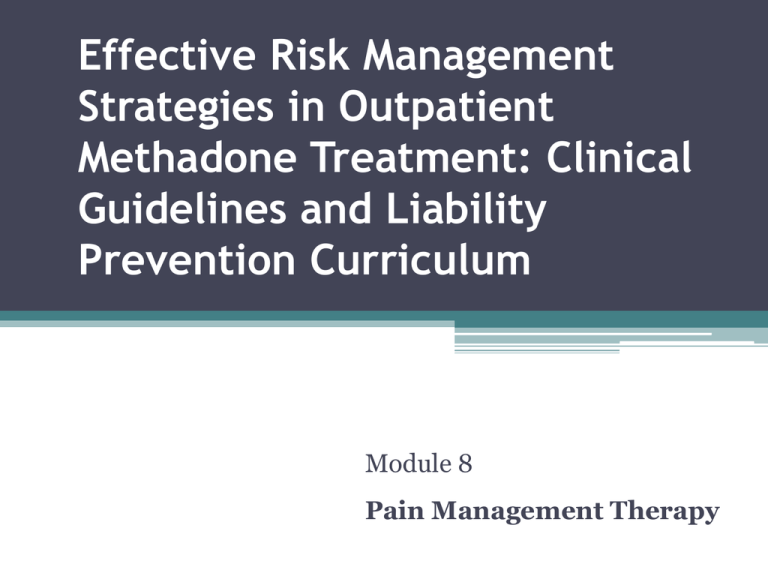
Effective Risk Management Strategies in Outpatient Methadone Treatment: Clinical Guidelines and Liability Prevention Curriculum Module 8 Pain Management Therapy Primary Indication for Use of Opioid Medications • Moderate to severe pain ▫ Acute pain ▫ Chronic pain • Opioid dependence Pain Prevalence Study Study of two populations1 ▫ 390 patients in MMT ▫ 531 patients in short term residential ▫ Prevalence of chronic severe pain ▫ Brief Pain Inventory (BPI) 1. Rosenblum A, et al Prevalence and characteristics of chronic pain among chemically dependent patients in methadone maintenance and residential treatment facilities; JAMA May 14, 2003 Vol 289: 2370-2375. Pain Prevalence Study • Higher prevalence of chronic pain in MMT population ▫ 37% vs. 24% compared with residential ▫ Higher than general population ▫ Prevalence of pain compared with surveys of cancer patients • Great variability in experience of pain ▫ Relatively high scores on items of BPI, 55% to 73% for pts in MMT • In MMT, chronic pain was associated with both physical and psychiatric illness • Less evidence of an association between substance use and chronic pain among inpatients vs MMT patients 1. Rosenblum A, et al Prevalence and characteristics of chronic pain among chemically dependent patients in methadone maintenance and residential treatment facilities; JAMA May 14, 2003 Vol 289: 2370-2375. Pain Prevalence Study • Patient Characteristics (MMT) ▫ ▫ ▫ ▫ ▫ Mean age 43 38% female 25% white 35% black 33% Hispanic 1. Rosenblum A, et al Prevalence and characteristics of chronic pain among chemically dependent patients in methadone maintenance and residential treatment facilities; JAMA May 14, 2003 Vol 289: 2370-2375. Under Treatment of Pain • Under treatment of pain is a significant concern in populations with substance use disorders • Barriers for inadequate pain management: ▫ ▫ ▫ ▫ ▫ Institutional practices Inadequate training and skills of clinicians Lack of access to health care, pain management care Reluctance of physicians to prescribe opioids Reluctance of patients to seek medical care: Stigma Fear of relapse 1. Rosenblum A, et al Prevalence and characteristics of chronic pain among chemically dependent patients in methadone maintenance and residential treatment facilities; JAMA May 14, 2003 Vol 289: 2370-2375. Pain Prevalence MMTP patients have been shown to have lower pain thresholds compared with matched controls1, 2 1. Compton M, Cold-pressor pain tolerance in opioid and cocaine abusers: correlates of drug type and use status J Pain Symptom Manage. 1994;9462-473. 2. Comptom P, et al. Pain intolerance in opioidmaintained former opiate addicts. Drug Alcohol Depend. 2001; 63:139-146. Relationship: Pain & Addiction Reference: Savage, S. Krish, K. Passik, S., Challenges in Using Opioids to Treat Pain in Persons With Substance Use Disorders, Addiction Science & Clinical Practice, June 2008 Terminology Distinction • Opioid Dependence • Tolerance • Physical Dependence • Opioid Addiction Dependence • A state in which an organism functions only in the presence of a drug • Manifested as a physical disturbance when the drug is removed (withdrawal) Tolerance • A state in which an organism no longer responds to a drug • A higher dose is required to achieve the same effect Opioid Addiction • Opioid tolerance • Physical dependence • Organism engages in compulsive behavior ▫ The behavior is reinforcing (rewarding or pleasurable) • Loss of Control Indices: ▫ Continued use despite adverse consequences ▫ Illicit or inappropriate drug-seeking behavior In response to craving or drug hunger Spectrum of Pain Disorders • Nocioceptive Pain • Neuropathic Pain • Mixed Pain Mechanisms • Acute Pain • Chronic Pain ▫ Non-cancer related /non-malignant pain ▫ Malignant pain Reference: Savage, S. Krish, K. Passik, S., Challenges in Using Opioids to Treat Pain in Persons With Substance Use Disorders, Addiction Science & Clinical Practice, June 2008 Acute Pain • Usually associated with an acute physical condition- etiology identifiable • Generally self-limited • Often primarily nociceptive • Sympathetic responses, increased blood pressure (BP), pulse (P), diaphoresis • Failure to treat acute pain properly may lead to chronic pain1 1 Dahl JB, Moiniche S (2004). "Pre-emptive analgesia". Br Med Bull 71: 13-27. PMID 15596866 Savage, S. Krish, K. Passik, S., Challenges in Using Opioids to Treat Pain in Persons With Substance Use Disorders, Addiction Science & Clinical Practice, June 2008 Chronic Pain • No longer serves survival or beneficial purpose • Lingered past limits normally associated with tissue healing • May persist because of chronic ongoing tissue pathology Degenerative Joint Disease Chronic pancreatitis Progressive cancer Reference: Savage, S. Krish, K. Passik, S., Challenges in Using Opioids to Treat Pain in Persons With Substance Use Disorders, Addiction Science & Clinical Practice, June 2008 Chronic Pain • Engenders secondary problems ▫ Sleep disturbance; anxiety; depressive symptoms; loss of normal functioning; increased stress associated with losses • Physiological basis may be difficult to determine • Objective physiological signs often absent, skepticism, mistrust • Acute exacerbations associated with chronic pain • Multidimensional approach to treatment Reference: Savage, S. Krish, K. Passik, S., Challenges in Using Opioids to Treat Pain in Persons With Substance Use Disorders, Addiction Science & Clinical Practice, June 2008 Chronic Pain Disorders & Opioids • Improvement, stable functioning • Opioid tolerance /opioid physical dependence • Adherent with treatment plan, scheduled visits • Absence of illicit drug use and aberrant drug seeking behavior ▫ ▫ ▫ ▫ No drug hunger in absence of pain No loss of control No “doctor shopping” Little tendency to escalate doses over time Pseudo-Addiction Chronic Pain Patient who is labeled an addict • Inadequate treatment of their pain • “Apparent” drug seeking behavior ▫ ▫ ▫ ▫ Effort to achieve adequate analgesia Early refill, doctor shopping, etc. Manipulation seen as “addictive behavior” Viewed as non-compliant • “Cured” by adequate treatment of pain Weissman, D.E.and Haddox, J.D. Opioid psuedo-addiction – An iatrogenic syndrome. Pain, 36 (3):363-366, 1989 Opioid Efficacy in Chronic Pain Expectations should be modest considering: ▫ Studies are surveys & uncontrolled case studies ▫ Randomized Clinical Trials (RTCs) short, small N ▫ Pharmaceutical sponsored ▫ Pain relief modest ▫ Limited or no functional improvement Balantyne JC, Mao J. NEJM 2003 Martell BA et al. Ann Intern Med 2007; Eisenberg E et al. JAMA. 2005 Eriksen et al (Pain - 2006) • Opioid users reported significantly : ▫ More moderate to severe pain ▫ Poorer self rated health ▫ Lower quality of life scores ▫ Low levels of physical activity and employment ▫ High levels of healthcare utilization Eriksen at al. Critical Issues on Opioids in Chronic non-cancer Pain: An Epidemiological Study. Pain 125(2006) 172-179. RM Strategies • • • • • • • Universal Precautions Opioid Risk Tool Patient Medication Agreement Opioid Agreement Guidelines for hospitalized patients Patient Informed Consent agreements FDA Warning guidelines Universal Precautions • Developed by Gourlay D, Heit H, Almahrezi A ▫ ▫ ▫ ▫ Biopsychosocial model for risk assessment Appropriate boundary setting and a respectful approach Recommendations for management and referral Adopting of this model: ◦ Stigma can be reduced ◦ Patient care improved ◦ Overall risk contained Gourlay D, Heit H, Almahrezi A, Universal precautions in pain medicine: a rational approach to the treatment of chronic pain. Pain Med. 2005 Mar-Apr;6(2):107-112. Universal Precautions • Diagnosis with appropriate differential • Psychological assessment • Informed consent • Treatment agreement • Pre/post assessment of pain level and function • TRIAL of opioid therapy with adjunctive therapy Pain Medicine: Volume 6 • Number 2 • 2005 Universal Precautions in Pain Medicine • Reassesses pain score and level of functioning • Regularly asses the “Four As”: ▫ ▫ ▫ ▫ Analgesia Activity Adverse reactions Aberrant behavior • Review pain diagnosis and co-morbid conditions • Documentation Opioid Risk Tool • Designed for initial assessment • 5-item initial risk assessment ▫ ▫ ▫ ▫ ▫ Family History Personal History Age Preadolescent sexual abuse Past or current psychological disease • Stratifies risk - low (6%), moderate (28%) and high (91%) Webster, Webster. Pain Med. 2005 Patient Medication Agreement • A patient medication agreement establishes clear expectations and specifies: ▫ ▫ ▫ ▫ ▫ Purpose of opioid therapy Side effects Treatment goals Physician’s role in responsible opioid prescribing Patient’s role in responsible opioid use Opioid Agreement • Opioid prescriptions are provided by only one Provider • Patients agree not to ask for opioid medications from any other doctor without the knowledge and assent of the provider • Patients keep all scheduled appointments • Urine drug screens obtained as indicated Opioid Agreement (continued) • Patients agree to comply fully with all aspects of the treatment program • A prohibition on use with alcohol, other sedating medications or illegal medications • Agreement not to drive or operate heavy machinery until medication-related drowsiness is cleared Pain Management Therapy: OTP Setting • Continue maintenance without interruption • Provide short-acting opioid analgesics • Higher doses may be required • Mixed agonists/antagonists or partial or weak agonists must be avoided • Monitor prescriptions closely *Scimeca,M.M., Treatment of pain in methadone-maintained patients, The Mt. Sinai Journal of Medicine, 67 (56):412-422., 2000 Guidelines for Hospitalized MM Patients • Discuss methadone treatment prior to admission • There should be a clear understanding regarding: ▫ Uninterrupted maintenance treatment ▫ Adequate treatment for pain ▫ Program physician should be available to hospital staff NPO for MM Patients • 24 hours after last oral dose of methadone: ▫ IM methadone, 40-50% of oral dose every 12 hours OR ▫ IM morphine sulfate 20-25% of oral methadone dose every 6 hours • Monitor for over/under medicating • Methadone for continued maintenance or substituted morphine, will not provide analgesia!! Methadone: FDA Black Box Warning • Indication – moderate to severe pain, non-responsive to analgesics • Initiated with consideration of risk/benefit, QT prolongation • Acute pain, appropriateness of methadone for stabilized patients • Duration of analgesic action • Difference in plasma elimination half-life of methadone vs. shorter acting opioids (8-59 hrs vs. 1-5hrs) • Peak respiratory effect occurs later, lasts longer than peak analgesic • Steady state plasma concentrations and full analgesic effects • Published equi-analgesic conversion ratios between methadone and other opioids are imprecise- caution when switching opioids Opioid Guidelines • Chronic pain is often a complex biopsychosocial condition. • Physician/Nurse Practitioners should integrate: ▫ ▫ ▫ ▫ Psychotherapeutic interventions Functional restoration Interdisciplinary therapy Other adjunctive non-opioid therapies Pharmacologic Pain Therapy • Nonopioid Analgesic Agents (NSAIDs) • Anticonvulsant Agents • Muscle Relaxants • Antidepressant Agents • Alpha Adrenergic Agents • Topical Agents • Opioid Analgesics • Vitamin D deficiency Non-pharmacologic therapy • Heat • Prosthetic supports • Physical therapy • Exercise • Cognitive-behavioral therapy (CBT) • Yoga • Relaxation Therapy • Meditation • Interventional pain therapy • Sleep evaluation • TENS Unit • Orthopedic consultation • Vocational Rehab • Chiropractic care • Recreational Therapy Summary • Acute and chronic pain syndromes are prevalent among patients in OTPs • Knowledge of the multidimensional nature and physiology of pain • Understanding that pain and addiction have a synergistic relationship • Best practice recommends a comprehensive approach with interventions using multiple modalities of care Summary: General RM Strategies • Assess and document benefits and harms • Collaboration and clear communication with PM specialists and or PCP • Patient education • Patient agreements • Careful and frequent monitoring Christina Nicolaidis, MD, MPH, Oregon Health & Science University. SGIM 2008 precourse

